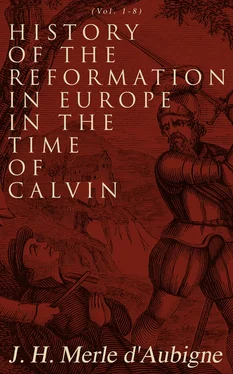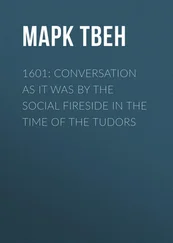The festival of Pentecost (Whitsunday) had been celebrated with great pomp on the 30th of May, 1528; but the devotionists, neglecting the Father, the Son, and above all the Holy Ghost, had thought of nothing all the day long but of worshipping the Virgin and her images. In the quarter of St. Antoine, and at the angle still formed by the streets Des Rosiers and Des Juifs, at the corner of the house belonging to the Sire Loys de Harlay, stood an image of the Virgin holding the infant Jesus in her arms. Numbers of devout persons of both sexes went every day to kneel before this figure. During the festival the crowd was more numerous than ever, and, bowing before the image, they lavished on it the loftiest of titles: ‘O holy Virgin! O mediatress of mankind! O pardon of sinners! Author of the righteousness which cleanses away our sins! Refuge of all who return unto God!’ 657These observances had bitterly grieved those who remembered the old commandment: Thou shalt worship the Lord thy God, and him only shalt thou serve .
On the Monday morning, the morrow after the festival, some passers-by fancied they observed something wrong in the place where the image stood: they could not see either the head of the Virgin or of the child. The men approached, and found that both the heads had been cut off; they looked about for them, and discovered them hidden behind a heap of stones close by; they picked up in the gutter the Virgin’s robe, which was torn and appeared to have been trampled under foot. These persons, who were devout catholics, felt alarmed; they respectfully took up the two heads and carried them to the magistrate. The news of the strange event quickly spread through the quarter. Monks and priests mingled with the crowd, and described the injury done to the image. Men, women, and children surrounded the mutilated figure—some weeping, others groaning, all cursing the sacrilege. A ‘complaint’ of the times has handed down to us the groans of the people:
Alas! how great the woe,
And crime that cannot pardoned be!...
To have hurt Our Lady so,
Lady full of charity,
And to sinners ever kind! 658...
Such were the sentiments of the good catholics who, with tearful eyes and troubled hearts, looked upon the mutilated image.
Who were the authors of this mutilation? It was never known. It has been said that the priests, alarmed at the progress of the Reformation and the disposition of the king, had perpetrated the act, in order to use it as a weapon against the Lutherans. That is possible, for such things have been done. I am, however, more inclined to believe that some hot-headed member of the evangelical party, exasperated at hearing that attributed to the Virgin which belongs only to Christ, had broken the idol. Be that as it may, the fanatical party resolved to profit by the sacrilege, and they succeeded.
Francis I., the most susceptible and most irritable of princes, considered this act of violence as an outrage upon his dignity and authority. As soon as he reached Paris, he did everything in his power to discover the guilty party. For two whole days heralds paraded the streets, and stopping at the crossways summoned the people by sound of trumpet and proclaimed: ‘If any one knows who has done this, let him declare it to the magistrates and the king; the provost of Paris will pay him a thousand gold crowns, and if the informer has committed any crime, the king will pardon him.’ The crowd listened and then dispersed; but all was of no use. Nothing could be learnt about it. ‘Very well, then,’ said the king, ‘I will order commissioners to go and make inquiry at every house.’ The commissioners went and knocked at every door, examining one after another all the inhabitants of the quarter; but the result was still the same: ‘No one knew anything about it.’
The priests were not satisfied with these proclamations. On Tuesday the 2nd of June, and during the rest of the week, the clergy of Paris set themselves in motion, and constant processions from all the churches in the city marched to the scene of the outrage. A week after, on Tuesday the 9th of June, five hundred students, each carrying a lighted taper, with all the doctors, licentiates, and bachelors of the university, proceeded from the Sorbonne. In front of them marched the four mendicant orders.
Beautiful it was to see
Such a goodly company;
Monks grey, black, of every hue,
Walking for an hour or two.
The reaction was complete. Learning and the Gospel were forgotten; men thought only of honouring the holy Virgin. The king, the Dukes of Ferrara, Longueville, and Vendôme, and even the King of Navarre, desired to pay the greatest honour to Mary; and accordingly on Thursday the 11th of June, being Corpus Christi Day, a long procession left the palace of the Tournelles.
In the front, with lighted tapers,
There walked a goodly show;
Then followed next the children,
Sweetly singing, in a row.
A crowd of priests came chanting,
And next marched him who bore 659The body of our Jesus ...
The canopy was carried
By the good King of Navarre,
And by Vendôme, and by Longueville,
And the proud Duke of Ferrare.
Then last of all there followed
The king with head all bare;
The taper in his hand was wrapped
In velvet rich and rare.
The different guilds, supreme courts, bishops, ambassadors, high officers of the crown, and princes of the blood, were all present. They walked to the sound of hautboys, clarions, and trumpets, playing with great state. When the procession arrived at the ill-omened spot, the king devoutly went up to it, and fell on his knees and prayed. On rising, he received from the hands of his grand almoner a small silver-gilt statue of the Virgin, which he piously set up in the room of the former one, and placed his taper before the image as a testimony of his faith. All the members of the procession did the same, as they marched past to the sound of the trumpets. The people manifested their joy by acclamations:
Long live the king of fleur-de-lys
And all his noble family!
Erelong the mutilated image, removed to the church of St. Germain, began to work miracles. Four days afterwards, a child having been brought into the world still-born,
The mother writhed and wept,
And bitterly groaned she;
And loudly prayed that death
Would take her suddenly.
She tossed and tumbled so,
That all the gossips there
Shed floods of bitter tears
And wildly tore their hair.
Then one who counselled wisely,
Said: ‘Take the child that’s dead,
And bear him to the Queen of Heaven!’ ...
Which they devoutly did.
The infant changed colour, adds the chronicle; it was baptised, and, after it had returned its soul to God, was buried. The miracle, it is clear, did not last long.
Notwithstanding all these tapers, miracles, and trumpet sounds, the king was still excited. Neither he nor the fanatics were satisfied. The flush which some fancied they saw on the cheeks of the poor little still-born child, was not sufficient; they wanted a deeper red—red blood. Duprat, the Sorbonne, and the parliament said that their master had at last come to his senses, and that they must take advantage of the change. Francis, who held the reins firmly, had hitherto restrained the coursers bound to his chariot. But now, irritated and inflamed, he leant forward, slackened the bit, and even urged them on with his voice. These fiery wild horses were about to trample under foot all who came in their way, and the wheels of his chariot, crushing the unhappy victims, would sprinkle their blood even upon the garments of the prince.
The persecution began.
CHAPTER XII.
PRISONERS AND MARTYRS AT PARIS AND IN THE PROVINCES.
Читать дальше







![Hubert Bancroft - The Native Races [of the Pacific states], Volume 5, Primitive History](/books/749157/hubert-bancroft-the-native-races-of-the-pacific-s-thumb.webp)




